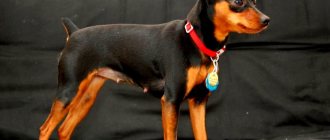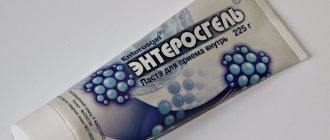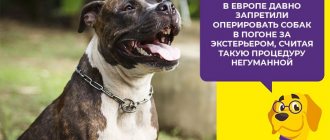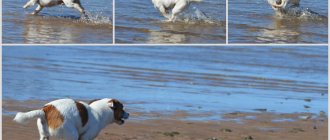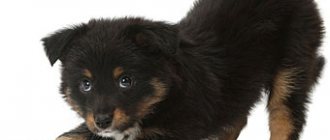Animal rights activists actively condemn this operation, citing its harshness and unreasonableness. Due to numerous disputes, it is not entirely clear whether it is possible to dock a dog’s tail or whether it is still worth preserving the natural appearance of the animal.
The official ban on amputation of the tail vertebrae in Russia has not yet been adopted, so the final decision remains with the owner. To avoid remorse, be sure to familiarize yourself with possible complications before signing up for the procedure.
What is cupping
Docking is the amputation of part of the tail by cutting or dragging. This procedure began in ancient Rome.
How did the idea of cutting tails come about?
The Romans docked their dogs for their own safety. Circumcision was performed on fighting breeds to reduce the likelihood of injury during gladiatorial fights. Also, a docked tail was the hallmark of hunting and herding dogs.
In the Middle Ages, people believed that short-tailed pets were reliably protected from rabies. Among the really weighty arguments are convenience and less trauma. The neat appendage collected less dirt and did not interfere with the pursuit of game in thorny bushes or a dark hole.
Not without human cunning. In the 18th century, Europeans docked their pets to evade taxes. It was charged for any purebred four-legged animals not engaged in official work. Whether a dog belonged to the police or security service was determined by the length of its tail, so unscrupulous owners quickly figured out how to reduce their expenses.
Do modern dogs need this?
Most modern pets do not perform their main functions (hunting, guarding). Owners are increasingly purchasing dogs for the soul - as ordinary companions. For this reason, in the 20th century, a convention was adopted in Europe that banned cupping at the national level. It was signed by most countries, including Australia and South Africa, which are very far from European territory.
As an exception, it was allowed to dock animals working in the police, army, rescue and deratization services. For everyone else, they made concessions, changing the established standards. The changes made allowed people to freely participate in dog shows without body modification.
Ear cropping – a procedure with history
The tradition of docking the tail and ears began hundreds of years ago. Even in ancient Rome, they resorted to this procedure to protect animals from rabies. How effective this manipulation was in terms of maintaining health is unknown, but later dog breeders found a more practical application for this procedure.
Owners of fighting breeds saw that with short ears and a tail, the animal is less vulnerable to bites from an enemy (another dog or game while hunting). In addition, cropped ears are less susceptible to punctures from foreign objects, bites from blood-sucking insects, etc. So, to some extent, the operation actually preserves the health of the pet.
At what age do dogs have their tail docked?
The owner decides when to dock a puppy’s tail, but veterinarians recommend not delaying it. After 1 month, pain sensitivity increases greatly, so it is best to circumcise before this point.
Surgery is easiest to tolerate in the first 3-10 days after birth. During this period, the tail vertebrae are very soft, and babies lack pain memory and increased sensitivity. For this reason, they do not require anesthesia or suturing, but animals older than 10 days are operated strictly under anesthesia.
How much does it cost to crop a dog's ears and tail?
Trimming a puppy's ears is usually inexpensive. Arriving at the clinic, the owner gives from 500 to 1000 rubles. The price includes admission, administration of anesthesia and treatment with antiseptics, as well as sutures and bandages.
Cropping the ears of an adult dog will cost an average of 2500-4000 rubles. Some clinics even charge 5000-6000 rubles. for the service.
Tail docking, like cropping a dog’s ears, depends on the age of the animal. For a period of up to 10 days, tail docking of puppies will cost the owners a symbolic 250 - 400 rubles in Moscow, and even cheaper in the regions. In the period from 10 days to 1 month, the procedure rises in price, to approximately 500 - 800 rubles. It is most expensive to dock the tail of an adult dog. Depending on the pet’s body weight, age and health status, docking costs from 1,000 to 3,000 rubles.
What dog breeds have their tails docked?
The mandatory presence of a docked tail is enshrined in the breed standard. The dog must conform to the exterior to participate in exhibitions and matings, but at this particular moment they increasingly turn a blind eye.
It is worth noting that many CIS countries and Russia still adhere to established traditions. Owners living there may find it difficult or even impossible to assign breeding or show class status to their pets if they refuse the operation.
List
The most famous representatives include
:
- poodles;
- kurtshaars;
- drathaars;
- Hungarian cops;
- Airedale Terriers;
- English and American cocker spaniels;
- boxers;
- Dobermans;
- toy terriers;
- Rottweilers.
The recommended tail length for these breeds is different. For this reason, it is very important to find an experienced veterinarian who is aware of all the nuances.
Determining the length of the ponytail
Most often, animals are left with 1/2-1/3 of their natural length or even 1-3 tail vertebrae. It all depends on the specific breed:
- poodles – 1/2-2/3;
- kurtshaars – 1/2-3/5;
- drathaars – 1/3-3/5;
- Hungarian cops – 1/2;
- Airedale Terriers – 1/3;
- English and American Cocker Spaniels – 2/5-1/2;
- boxers – 2-3 vertebrae;
- Dobermans – 2-3 vertebrae;
- toy terriers – 2-3 vertebrae;
- Rottweilers – 1-2 vertebrae.
Exceptions include wolfhounds. Their final length is determined solely by the owner.
When and why do dogs have their tails and ears docked?
Tails and ears are trimmed at different times. For each breed there is a certain time frame within which the operation must be performed. Thus, the tails of dogs of large breeds (Rottweiler, Doberman) are cut on the 2-3rd day after birth. Schnauzers, spaniels and representatives of other medium breeds on the 4-5th day after birth. Babies' tails are cut at the age of 5-7 days. Such an early date for the operation is due to the fact that the vertebrae of the tail part of the body are still soft, cartilaginous. Anesthesia at this age is strictly contraindicated for puppies, but the low pain threshold allows for relief without anesthesia, and wounds from the cut heal quickly and without problems.
Ear cropping is a more complex procedure. It is carried out at a later age, namely at 2-3 months. The main difficulty is to correctly determine the size of the ear, since the puppy is still growing and the proportions of the head and body are changing.
Docking is carried out according to the rules and in accordance with the requirements of breed standards. Previously, this was necessary for the dog to be recognized as a purebred and allowed to participate in exhibitions and breeding programs. Today, the operation in most cases remains at the discretion of the breeder.
Contraindications and prohibition for surgery
Contraindications include any health problems: weakness, loss of appetite, inflammatory reactions, infections. There is also an age limit. After 1 month, animals are not operated on. An official ban on surgical intervention has been adopted in all countries that have signed the European Convention.
How the process works
Tail docking for puppies is carried out in 2 ways: using a tight rubber band or cutting with scissors. The first option is less traumatic and is performed without anesthesia.
Drag method
The veterinarian pulls the baby's skin to the base of the tail, finds the desired vertebra and secures it tightly with an elastic band. This tourniquet stops the blood flow, so within 5-7 days the tip dries out and falls off. The risk of bleeding is minimal, so sepsis is practically excluded.
Circumcision method
After anesthesia is administered, the desired area is fixed with fingers and trimmed. To stop bleeding, the cut site is clamped for 2 minutes, and to prevent infection, it is treated with an antiseptic.
The skin stretched to the base is returned and sutured, applying a sterile bandage. A crust forms at the amputation site, which disappears after 20-30 days.
Amputation of the caudal vertebrae in puppies under 7 days of age
Tail amputation is a surgical procedure performed to remove a section of the tail. Most often, this procedure is performed as a cosmetic procedure for certain breeds of dogs (Fig. 1). Also, tail amputation can be a therapeutic procedure for neoplasms, necrosis, non-healing wounds, fractures and ulcers in animals.
Cosmetic amputation of the caudal vertebrae
has been carried out for certain breeds since ancient times and is considered the standard for these breeds. Hunting dogs undergo tail amputation to prevent damage to the tail when walking through dense brush. Tail amputation of fighting dogs is carried out in order to reduce injuries in battles. Currently, tail amplation is carried out only for aesthetic purposes; in Figure 2 you can compare what a dog of the same breed looks like with a docked tail and without docking.
A B
Figure 2 - Dogs of the Doberman Pinscher breed (A - with an undocked tail, B - with a docked tail).
It is best to perform tail amputation on puppies up to 10 months of age, since it is during this period that pain sensitivity is very weak and the vertebrae are not yet fully formed, and therefore the procedure at this age is almost painless. The earlier the amputation is performed, the less pain the animal experiences. Tail amputation can be performed at an older age, but in this case both local and general anesthesia (anesthesia) will be required.
How long should the tail be for different breeds?
| Breed | Tail length after amputation |
| Boxer | 2-3 vertebrae (to cover the anus) |
| Doberman | 2-3 vertebrae (to cover the anus) |
| Toy Terrier | 2-3 vertebrae (to cover the anus) |
| Rottweiler | 1-2 vertebrae (to cover the anus) |
| Airedale | 1/3 tail length |
| Spaniel | 2/5-1/2 tail length |
| Hungarian pointer | 1/2 tail length |
| Poodle | 1/2-2/3 tail length |
| Kurzhaar | 1/2-3/5 tail length |
| Drathaar | 1/3-3/5 tail length |
ATTENTION!!!
For puppies up to 7 days, tail amputation is performed without the use of general anesthesia, under local anesthesia; at the age of 7-20 days, infiltration anesthesia and muscle relaxation are used; at older ages, the operation is performed only under anesthesia.
How is the operation performed?
Before amputation, the tail section is well trimmed and treated with an antiseptic solution. The instruments needed for tail amputation must be sterile. The size of the amputated area is determined based on the breed of the dog. To amputate the tail, the skin is shifted to the base of the tail, a thickening (intervertebral disc) is found by palpation and the tail is cut off at this point with a scalpel, the rest of the vertebra is isolated. The skin is sutured with an interrupted suture so that the upper flap covers the exposed area of the vertebra. Then the seams are treated with an antiseptic solution. At first, you need to make sure that the bitch does not lick the puppies’ tails, this can lead to longer healing. Suture removal is usually carried out on days 7-14.
ATTENTION!!!
Tail amputation as a cosmetic surgery is not a mandatory procedure and the decision to perform it is made by the owner.
Therapeutic tail amputation is performed
for non-healing wounds, fractures (Fig. 3), ulcers (Fig. 4), necrosis, neoplasms, improper tail growth (Fig. 5).
Figure 3 – Tail fracture.
Figure 4 – Tail ulcers.
Figure 5 – Incorrect tail growth, typical only for English and French bulldogs, when the vertebrae curl towards the animal’s body.
ATTENTION!!!
Therapeutic tail amputation is performed under general anesthesia. In this regard, as before any surgical intervention, it is necessary to conduct a preoperative examination of the animal to exclude possible contraindications to anesthesia. Preoperative preparation includes taking clinical and biochemical blood tests, an ECG, and, if necessary, performing an X-ray and ultrasound. Before surgery, the animal is kept on a fasting diet for at least 8 hours.
Surgery technique and size of the amputated section of the tail
determined by a veterinarian based on the degree of damage to the tail. The animal wears a protective collar until the stitches are removed. Sutures are usually removed within 10-12 days. In case of tumors of the tail after surgery, it is necessary to send the amputated area for histological examination to determine the nature of the tumor.
Animal after surgery
The main arguments against the procedure are postoperative pain and the loss of the main communication tool. There is also a possibility of complications, so monitor the condition of your four-legged pet very carefully during the postoperative period.
Is it painful for the puppy?
Surgery involves bones, cartilage and muscles, so the answer to this question is obvious. The pain continues in the postoperative period, when the anesthesia wears off. Not all pets have a high pain threshold. Particularly sensitive babies will cry for a long time and can even damage their vocal cords from too high-pitched whining.
Psychological factor
A dog's docked tail often provokes behavioral disorders. Due to impaired communication function, animals after surgery can withdraw into themselves and even show aggression towards their owners.
Communication methods
With a small appendage, it is very difficult to convey emotions and communicate with other four-legged animals. Most dogs avoid dogs with docked tails. They are less likely to approach them to get to know each other and very often show unreasonable aggression.
Are there any complications?
Most often, complications arise during tail docking in adult dogs. But here the blame falls entirely on the owner, who neglects contraindications.
Problems in children usually arise due to non-compliance with sterility or insufficient wound treatment in the postoperative period. In addition to bleeding and suppuration, it is worth noting the increased likelihood of scarring with prolonged healing. Such scars greatly spoil the appearance of the ponytail.
We should not forget about the deterioration of motor skills due to the loss of the “steering wheel”. This affects maneuverability and provokes improper distribution of the load on the hind legs and pelvic region. In some pets, this leads to muscle atrophy, limb deformities, intervertebral hernias and chronic pathologies of the genitourinary system.
How does the operation take place?
Tail surgery occurs in two ways:
- The first, and least painful method involves removing the organ with surgical scissors within three days of the puppy’s birth. The operation does not require anesthesia and does not require stitches. Ideally carried out by veterinarians, but can also be carried out by breeders at home.
- The second method is to apply a special rubber band (ligature) to the tip of the tail. The ligature does not allow blood access to the tip, and after a few days it falls off on its own.
Here's how ear cropping works. Here, anesthesia is required for the dog, since the procedure itself is quite painful. You cannot feed the animal 12 hours before surgery. The dog is fixed on the operating table after a dose of novocaine or antipsychotic is administered. Sometimes the operation is performed under general anesthesia. The circumcision process itself occurs using a scalpel. After the cupping procedure, the wound is sutured and treated with antibacterial agents. The duration of the operation generally takes from 30 minutes to 1.5 hours.
Rehabilitation period
After docking the tail, monitor the puppy for several hours to avoid bleeding. Kutya heals quite quickly and without complications.
After ear surgery. To prevent the animal from scratching the seams, a special plastic frame is put on it. If the animal feels pain and constantly rushes about and whines, it is prescribed painkillers. Also spend a lot of time on the seams, they need to be constantly processed. For disinfection, use hydrogen peroxide, brilliant green, calendula tincture or streptocide.
The stitches are removed after a couple of weeks, but the rehabilitation period does not end there. If, after removing the stitches, they have healed correctly, ears will still need to be fitted for the owner and dog.
Possible complications
What a docked tail can theoretically affect:
- communication with animals and socialization. Since this organ is the dog’s means of communication, its removal may affect the perception of it by other animals. Relatives are more aggressive towards bob-tailed dogs, as they do not always correctly perceive their behavior and motives;
- increased aggression. It has been statistically proven that docked dogs are more aggressive than their relatives with healthy tails;
- joint problems. Due to improper distribution of the load on the hind limbs, the animal may develop a hernia in the future. Also, removal of the tail is fraught with the development of deformities of the fingers of the hind limbs;
- motor skills. The tail is not only a way of communication, but also an important regulator of the animal’s movements. Due to its absence, some problems with motor skills arise. Ordinary dogs do not skid as much when turning as docked dogs;
- psyche. Research shows that tail removal, even at an early age, is very painful for the puppy and the shock experienced can lead to mental problems in the future.
Ear cropping is fraught with all sorts of infectious diseases. The dog's ears become open to rainwater, dust and dirt, which can lead to serious illnesses. In addition, if the operation was performed by a non-specialist, the animal’s sutures may not heal properly.
Postoperative care
The owner must carefully monitor the dryness and cleanliness of the postoperative wound until it heals. Additional treatment is discussed with your veterinarian. Moisturizing ointments inhibit the regeneration process, so they are used only for their intended purpose.
If there are any signs of suppuration, contact your veterinarian immediately. Temporary separation from the mother will also be required. If she persistently licks the puppies' wounds, isolate her in a separate room and bring her to the pups only for feeding.

